|
|
|
Sort Order |
|
|
|
Items / Page
|
|
|
|
|
|
|
| Srl | Item |
| 1 |
ID:
148099


|
|
|
|
|
| Summary/Abstract |
Iran, Afghanistan and India have long ancient traditions of social-cultural, religious, political and economic contacts since remote antiquity.1 These regions have common and contiguous borders, climatic continuity, similar geographical features and geo-cultural affinity. There has always been uninterrupted flow of people, material and the ideas among these countries.
|
|
|
|
|
|
|
|
|
|
|
|
|
|
|
|
| 2 |
ID:
148109
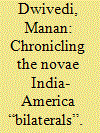

|
|
|
|
|
| Summary/Abstract |
Prime Minister Narendra Modi has too declared that “these shadows of hesitance between the twin nations should be done away through the C’s of candor and convergence.” The American President has too termed the India-US “bilaterals” as the “defining partnership of the century”. It’s a strain of Complex Interdependence which is associated with the “bilateral singularity” of the India-US tryst with a Manifest Destiny argument. Both the nations, in accordance with the IR observers, have lived up to the “Altercating” and a constructivist world view, that the two states of India and America will learn and are being already educated with each other’s culture, Diaspora and the intertwining of the strategic, defense and geo economic considerations prevalent in the world polity.
|
|
|
|
|
|
|
|
|
|
|
|
|
|
|
|
| 3 |
ID:
148101


|
|
|
|
|
| Summary/Abstract |
The interplay of geopolitics and grand strategy influence the international scenario by bringing out collaborations and competitions among the nations. It has been noticed that the partnerships between India and US critically investigate the “new geopolitics” of an emerging multipolarity and the renewed interest in geopolitical narratives in the 2000s and beyond. This phenomenon is well connected with the emerging powers including China and Russia. It is also very much influenced by the noticeable shift of economic power away from the West. Keeping the changing nature of contemporary geopolitics in the background, the article attempts to define the renewed partnerships of India and United States in the 21st Century.
|
|
|
|
|
|
|
|
|
|
|
|
|
|
|
|
| 4 |
ID:
148098
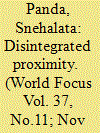

|
|
|
|
|
| Summary/Abstract |
Geography is as much an advantage as it is a problem to cultivate and maintain good relationship with India’s South Asian neighbours. A plethora of territorial,historical ,cultural and ethnic problems have persistently disturbed bilateral relationship. In all these countries there are sections supporting engagement with India and opposing it. Bilateral relationship vacillates between good and worse according to the section that holds the reins of political power though in case of Pakistan influence of the military remains constant.
|
|
|
|
|
|
|
|
|
|
|
|
|
|
|
|
| 5 |
ID:
148111
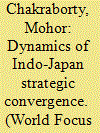

|
|
|
|
|
| Summary/Abstract |
In the annals of Indian foreign policy, the ‘Look East’ policy, practised for more than two decades, has provided the desired impetus to the country’s Southeast, East Asian and Asia-Pacific neighbourhood, also referred to as its “extended neighbourhood.” With the inauguration of the second tenure of the National Democratic Alliance/NDA government in May 2014, the ‘Look East’ Policy, re-christened ‘Act East’, has assumed new dynamism and vitality. In this respect, Japan has emerged as a fulcrum in India’s policy computations as validated by the Prime Minister of India, Narendra Modi’s selection of Japan as the first port of call (31 August–3 September 2014) outside the immediate neighbourhood. This visit was reciprocated by the Japanese Premier, Shinzo Abe in December 2015.
|
|
|
|
|
|
|
|
|
|
|
|
|
|
|
|
| 6 |
ID:
148114
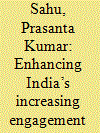

|
|
|
|
|
| Summary/Abstract |
The disintegration of USSR was an important incident in international politics; it changed the structure of international relations in the 1990s. This dramatic event also changed the scenario of the international politics at the global level. It was this event that ended the system of Cold War military blocs and the bipolar world order in international relations, which had created rivalry and competition between the two blocs. After that, the former USSR’s allies, especially the Third World countries, reoriented their policies to suit the Western model of globalization led by the US.
|
|
|
|
|
|
|
|
|
|
|
|
|
|
|
|
| 7 |
ID:
148100
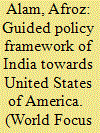

|
|
|
|
|
| Summary/Abstract |
India has to play a central role in turning the 21st century as Asian Century by strengthening its relations not only with its neighbouring and other Asian counties but also with global political and economic powers in a ‘grow together’ atmosphere without compromising its strategic interests in balancing the resurgent China and hostile Pakistan. In this backdrop, it now depends almost entirely on how India plays its cards to nurture its relationship with the US to play a meaningful role at the global arena.
|
|
|
|
|
|
|
|
|
|
|
|
|
|
|
|
| 8 |
ID:
148102


|
|
|
|
|
| Summary/Abstract |
India’s Act East Policy came along with the BJP leader Narendra Modi winning the 2014 election in India. Prime Minister N. Modi participated in ASEAN-India Summit and East Asia Summit in November 2014. In these summits, Prime Minister Modi officially announced India’s upgrade of Look East Policy to the Act East Policy.1 A month later, in the International Relations Conference on ‘India’s Look East - Act East Policy: A Bridge to the Asian Neighbourhood’ held in Pune, India, the Secretary (East) of India’s Ministry of External Affairs partly mentioned in his address of the context, scope, objectives and deployment directions of the policy.
|
|
|
|
|
|
|
|
|
|
|
|
|
|
|
|
| 9 |
ID:
148115
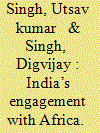

|
|
|
|
|
| Summary/Abstract |
Indian economy has entered in the 25th year of liberalization in year 2016. “In 1991, India was infamous as the world’s biggest beggar, a bottomless pit for foreign aid. It soaked up 40% of the funds of the International Development Association (IDA), the soft-loan window of the World Bank. Today, India is as much a donor as a recipient. It is still a substantial aid recipient in gross terms. But the inflow is barely half-a-billion dollars net of debt service.
|
|
|
|
|
|
|
|
|
|
|
|
|
|
|
|
| 10 |
ID:
148103
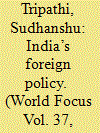

|
|
|
|
|
| Summary/Abstract |
In fact, several recent developments in the upcoming international scenario have ushered into important changes in India’s foreign policy structure under PM Modi which have led to forge New Delhi’s closer relations with US, Australia, Japan and other major western powers. Evidently, that manifests a more pragmatic interest-oriented foreign policy of the country with a view to make India a self-sustaining economic power with sociopolitical stability and potentially sound security structure. Although it has prompted to pursue proAmerican stand on all intenational issues in the recent past, yet this shift in Indian foreign policy has not yet materialised into the US fulfilling India’s long pending demand to force Pakistan to stop exporting cross-border terrorism into the country and restraining China’s anti-Indian activities with likely formation of BeijingIslamabad unholy axis against New Delhi, besides securing a permanent seat for India in the UN Security Council.
|
|
|
|
|
|
|
|
|
|
|
|
|
|
|
|
| 11 |
ID:
148112
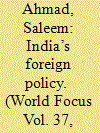

|
|
|
|
|
| Summary/Abstract |
In fine, there is no doubt that the leadership style of the PM Modi has raised the credit of India at the international level and his fresh coat of paint on India’s foreign policy has also created its image as a leading power in the 21st century. PM Modi’s unique approach to the Indian foreign policy has played a significant part in emerging ties with the leading countries of the world and the future of India’s foreign policy looks very bright. In the era of globalisation, where geoeconomics has become prime centre of the world countries, therefore, PM Modi has also focussed on the Indian foreign policy and fine-tuned according to the need of hour, and during his half tenure, the fruits of changes in Indian foreign policy have become visible, and one can see that, at present, India and the United States of America have become very close to each other than earlier and both are standing at one platform and therefore the 21st century will be witnessed of their close partnership.
|
|
|
|
|
|
|
|
|
|
|
|
|
|
|
|
| 12 |
ID:
148107
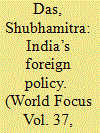

|
|
|
|
|
| Summary/Abstract |
India’s foreign policy in the 21st Century is appraised due to the interplay of geoeconomics with geopolitics and India’s search for a visible and a constructive role on the global map, the need for sustainable economic growth, energy security, food security and border disputes on the one hand and the United States’ Pivoting Asia and expecting India to take the lead role on the Indian Ocean. Therefore the core policy paradigm Nonaligned Movement (NAM) has come into strict scrutiny. The paper will deal with Non-aligned Movement from three angles a) NAM being the central factor in India’s foreign policy making, b) India’s role in NAM, c) NAM and Indo-US relation.
|
|
|
|
|
|
|
|
|
|
|
|
|
|
|
|
| 13 |
ID:
148116
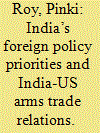

|
|
|
|
|
| Summary/Abstract |
Arms sales have become, more than ever before, a crucial dimension of world politics. They are now major strands in the warp and woof of international affairs. Arms sales are far more than an economic occurrence, a military relationship, or an arms control challenge-arms sales are foreign policy writ large.
|
|
|
|
|
|
|
|
|
|
|
|
|
|
|
|
| 14 |
ID:
148108
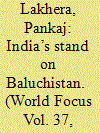

|
|
|
|
|
| Summary/Abstract |
Prime Minister Narendra Modi’s remarks on Baluchistan marks a paradigm shift in India’s foreign policy. Our foreign policy has now become proactive and pragmatic. The present paper wishes to explore its impact on relations between India and Pakistan. It will also tend to analyze these developments in the light of spirit of SAARC. What can be the ways for bringing peace and prosperity in SAARC region.
|
|
|
|
|
|
|
|
|
|
|
|
|
|
|
|
| 15 |
ID:
148106
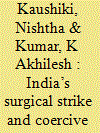

|
|
|
|
|
| Summary/Abstract |
India had been virtually driven to the wall in the wake of yet another terrorist attack on Indian army base in Uri. It has revived the memories of the Kaluchak and Pathankot attacks, and, 26/11. As India was caught unaware, it was probably believed by the government in power that an absolute majority in the Parliament and, after a stern warning after the Pathankot attack, Pakistan would probably not attempt any other mischief. While addressing a rally in Kerala, Prime Minister Narendra Modi stated that India will neither forget nor forgive the enormity of the Uri attack. This was also further followed by External Affairs Minister Sushma Swaraj’s evocative speech at the United Nations General Assembly (UNGA). However, the surgical strikes were unexpected given the policy of strategic restraint that India had followed in the past and indeed it was a resolute decision.
|
|
|
|
|
|
|
|
|
|
|
|
|
|
|
|
| 16 |
ID:
148110
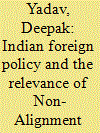

|
|
|
|
|
| Summary/Abstract |
The NAM has succeeded to create a strong front on the International level, representing countries of the third world in the International organizations on top of which the United Nations. Current Challenges facing the NAM include the necessity of protecting the principles of International law, eliminating weapons of mass destruction, combating terrorism, defending human rights, working toward making the United Nations more effective in meeting the needs of all its member states in order to preserve International Peace, Security and Stability, as well as realizing justice in the international economic system. On the other hand, the long-standing goals of the Movement remain to be realized.
|
|
|
|
|
|
|
|
|
|
|
|
|
|
|
|
| 17 |
ID:
148097


|
|
|
|
|
| Summary/Abstract |
The Indian Prime Minister Narendra Modi had the latest meeting with the Russian president Vladimir Putin at G-20 summit in China in September 2016 even as both the leaders have met several times during the last about two years reconfirming the chemistry of close and cordial bilateral relations and Russia consistently supporting India in various regional and global organizations. For instance, both the leaders met in Tashkent on 26th June 2016 on the sidelines of SCO meeting during which Putin welcomed India signing the Memorandum of Obligations of SCO that has kick-started the process of India’s accession as ‘full member’ into this powerful regional grouping since India will have to sign around 30 other documents to complete the process for membership.
|
|
|
|
|
|
|
|
|
|
|
|
|
|
|
|
| 18 |
ID:
148105
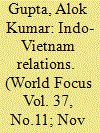

|
|
|
|
|
| Summary/Abstract |
Present Indian political dispensation has articulated its ‘Act East’ policy and seems to be pursuing aggressively to make it happen as well as strengthen it in a meaningful manner. India desires to play a more assertive and constructive role in the larger Indo-Pacific. Prime minister while addressing to the joint session of the US Congress made it explicit that a strong India-US partnership can anchor peace, prosperity and stability from Asia to Africa and from Indian Ocean to the Pacific. It can also help ensure security of the sea lanes of commerce and freedom of navigation on seas.
|
|
|
|
|
|
|
|
|
|
|
|
|
|
|
|
| 19 |
ID:
148104
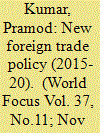

|
|
|
|
|
| Summary/Abstract |
Indian diplomacy is on the fast track whether it is political or economic matter. Prime Minister Modi hinted it from the day one of his office that he has come with a vision and to fulfil it will need a speedy and concerted effort. He travelled to number of countries big or small and succeeded in establishing new relationship with them based on mutual trust and dependency more than before. Prime Minister’s untiring efforts are fetching result in the political arena and soon it is hoped it would be translated in the economic scenario too.
|
|
|
|
|
|
|
|
|
|
|
|
|
|
|
|
| 20 |
ID:
148113
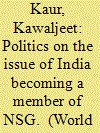

|
|
|
|
|
| Summary/Abstract |
Recently there was much flurry both in the media as well as in the corridors of power in New Delhi regarding India’s bid for the membership of the Nuclear Suppliers Group which was holding a plenary session in Seoul (South Korea).The Prime Minister Narindra Modi, himself led the endeavour by reaching out to different countries to obtain for India ‘the global acceptance as a legitimate nuclear power’ which would enable New Delhi to import nuclear technology and fuel from international market more conveniently. With the explicit backing of the USA, as in the successful attempt of President Bush in 2008 getting a special waiver for India from NSG to do trade in nuclear technology for peaceful purposes, India hoped to achieve a déjà vu by getting a membership of the elite group itself.
|
|
|
|
|
|
|
|
|
|
|
|
|
|
|
|
|
|
|
|
|